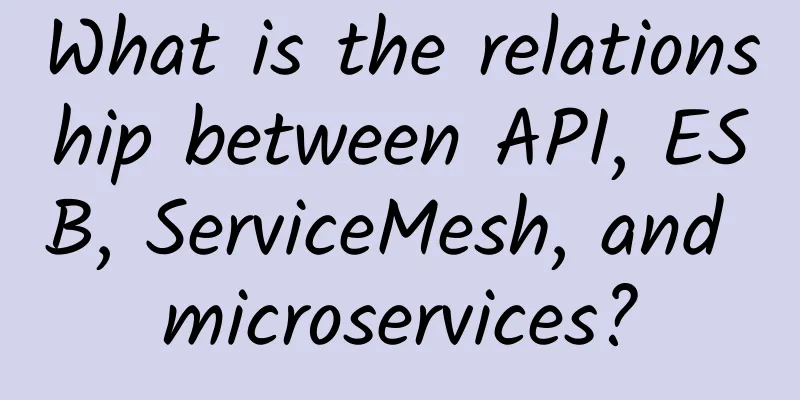What is the relationship between API, ESB, ServiceMesh, and microservices?

IntroductionI mentioned before that I would like to introduce the API Gateway. In fact, whether it is microservices, service mesh, cloud native, or digital construction, the API Gateway is an unavoidable topic. Since the introductions of the API Gateway on the Internet vary, today we will no longer simply introduce the basic knowledge and functions of the API Gateway, but will go straight to the point and talk about the relationship between ESB, ServiceMesh, microservices, and API Gateway.
01 The Core of API GatewayWith the widespread use of microservice scenarios, API gateways have gradually attracted attention. Aggregating interfaces and services to provide front-end calls and business encapsulation is the main scenario of API gateways. The API gateway is a bridge between internal and external business communications or the front and back ends of the system. In addition to establishing communications and routing forwarding, it also undertakes many non-business functions, such as security, flow control, filtering, caching, monitoring, etc.; in the service-oriented model, some operational functions will also be added, such as API management, metering and billing, service subscription, etc. It can be seen that we can do a lot on the API gateway, just because it undertakes and forwards the traffic, which is also the core of the API gateway. This role is not unfamiliar. The ESB and ServiceMesh mentioned in my previous two articles both rely on the traffic reception and forwarding functions to form solutions. The same tool, placed in different positions, has different forms. API Gateway is such a tool. 02 The relationship between API, ESB, ServiceMesh, and microservicesScenarios for replacing ESBThere is no need to introduce ESB in depth. Its core is also routing, forwarding, conversion, and flow control. As ESB gradually withdraws from the digital stage, most companies are also thinking about how to gradually replace ESB with a substitute. We at Boyun have made a variety of solutions and functions for smoothly replacing ESB through microservice framework and service grid framework in multiple projects. At the same time, it covers its original routing forwarding, protocol conversion, and flow control functions. The most direct solution is to implement it through API gateway. The ESB architecture is responsible for both east-west access control and north-south traffic control. The solution using the API gateway is more flexible. Its scalable size, flexible dynamic configuration, and self-service consumption model are more in line with the diverse new digital architecture. If planned properly, the API gateway can replace the ESB while also serving as a gateway for the entire network domain or even the entire enterprise. This is the first step in the service middle platform. Applications in a service meshThe concept of ServiceMesh is actually very easy to understand. Through a proxy service, all traffic is taken over, and non-business governance, monitoring and other functions are implemented through the proxy service. Then this proxy service (proxy) is another application scenario of API gateway. Hijack the traffic and then add the required customized functions. Compared with other scenarios, the gateway function here has not changed much, but the location of use is very different. In the ServiceMesh scenario, the gateway is a very small and lightweight proxy unit, and each business operation unit will be equipped with the proxy unit to start together, so in the ServiceMesh scenario, it is usually called a sidecar. In other words, the Sidecar in ServiceMesh is an API gateway application. For example, in the Istio framework, the data plane Sidecar is Envoy (an API gateway based on the C++ language). Microservice GatewayIt is worth mentioning the API gateway in the microservice scenario. Isn't this scenario the most basic application? In fact, the microservice gateway is also the result of the scenario-based transformation of the API gateway. For example, SpringcloudGateway and Zuul are microservice gateways developed in Java based on the netty framework, and are mainly used in the Springcloud microservice scenario. In the microservice scenario, the addressing of inter-service communication needs to rely on the registration center. When the microservice gateway performs routing forwarding, the upstream address also needs to be obtained from the registration center. At the same time, when the microservice accesses the gateway, it can also be addressed directly through the registration center. Therefore, the microservice gateway needs to comply with the registration and discovery mechanism of the microservice framework. 03 ConclusionThe core of the three types of gateways are communication proxy and forwarding. When replacing ESB, they have the feature of protocol conversion. When connecting to microservices, they add the function of synchronization with the registration center. When acting as a sidecar, they need to hijack traffic and communicate with the control plane. In addition, there is the scenario of API market that has not been mentioned. This scenario requires the addition of metering and billing functions. Therefore, according to different usage scenarios and different application methods, you can freely adjust it by relying on the API gateway. In Boyun, at least three types of gateways and multiple scenarios are involved. The first type: enterprise-level API gateways, which mainly focus on providing service capabilities and handle the traffic of the entire enterprise, so they have extremely high requirements for the performance of the gateway. The component we use is based on openresty+lua's kong to solve the problem, and the performance guarantees the interaction pressure of the entire enterprise. The second type: microservice gateway, which is mainly the encapsulation of microservices, but it is not the focus and difficulty. Through the delivery of many projects, it is found that the needs of microservices are easy to meet, but the transition solution is more difficult. The so-called transition solution refers to the Sidecar solution made by API gateway when non-microservice applications need to be uniformly governed with microservice applications. We use SpringcloudGateway internally in Boyun, and perform protocol conversion, service detection and other functions on it to achieve unified management and governance of monolithic applications and traditional architecture systems. The third type: service mesh, which is mainly the data sidecar part. The difference is that the microservice framework above is basically determined to be Springcloud, while the service mesh originally uses the Istio framework inside our Boyun, and the sidecar under the Istio framework uses Envoy. We expand the ESB scenario and the traditional architecture compatible scenario on Envoy, and add protocol support, protocol conversion, data collection, link collection and other functions to meet the complex microservice transformation needs. The formation is the basis for fighting, and the key to success lies in one's heart. The technology of API gateway is almost mature, and its reasonable application in the right scenario will play a great role. |
<<: China Mobile proposes five measures to meet the challenges of 5G for cultural and media services
Recommend
Aruba announces integration with Xinshangan IoT System to enable smooth integration of Wi-Fi and IoT
Recently, Aruba, a subsidiary of Hewlett Packard ...
5G co-construction and sharing: the simple "saving money" mentality is not advisable
On June 6, after China issued 5G commercial licen...
80VPS: Hong Kong dedicated server 100M bandwidth 450 yuan/month, US CN2 server 350 yuan/month
80VPS is promoting some independent servers. For ...
LRU implementation with expiration time
[[382833]] I saw this algorithm a long time ago w...
Why the coronavirus pandemic makes 5G more important than ever
While 2020 has brought unprecedented challenges, ...
Building the nervous system of smart cities | Huawei shines at the 19th CHTF
On November 16, the 19th China Hi-Tech Fair (CHTF...
What magical things happen when you enter a URL in your browser?
After entering the URL in the browser, the websit...
The Future of 5G and IoT in Smart Cities
[[438866]] In short, a "smart city" lev...
Hostmem: $11.99/year KVM-512MB/10GB/500GB/Los Angeles data center
Hostmem is a Chinese VPS service provider. The tr...
Krypt: ION Cloud Platform 2nd Anniversary San Jose CN2 GIA/Singapore CN2 GIA 20% off
Time flies. It has been two years since Krypt lau...
Breaking the “lack of core and soul”, my country successfully developed 5G millimeter wave chips
According to Science and Technology Daily, on Jun...
5G "new infrastructure", new scenarios, new models
Since the beginning of the year, the central gove...
IPv4 addresses are exhausted, but the utilization rate of IPv6 addresses in China is only 0.5%
"With the widespread and in-depth applicatio...
How 10 popular SD-WAN startups survive in the cracks
The SD-WAN market is very hot. Large enterprises ...
Maxthon Hosting: Los Angeles data center connected to AS9929 line, 20% discount, monthly payment starting from 38 yuan
Aoyou Host is a long-established foreign VPS host...









